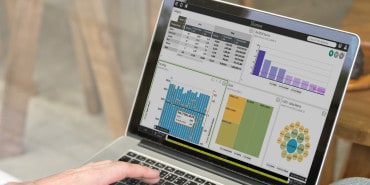
Just like the queen is the strongest chess piece, data is the strongest tool for optimizing networks to handle society’s connectivity demands.
I’ve heard “data is king” repeated throughout my telecommunications career. However, why can’t data be queen? Real-time data can be harnessed in numerous ways to improve network quality, much like a queen chess piece can move many spaces in multiple directions to achieve a goal. When derived from real-time network analysis, data provides us with a comprehensive understanding of network topology changes, security threats, performance metrics, energy consumption levels, capacity utilization, and much more. We can move beyond analytical structures into decisive action and even network automation with modern network analysis.
By harnessing these real-time insights for automation, global Internet carriers can improve network quality to help global enterprises unlock digital transformation. Due to these diverse uses, data is queen as much as it’s king. But before we explore the four types of network analysis, let’s investigate the role of data in ensuring networks can handle tomorrow’s demands.
Ensuring Networks Can Handle Tomorrow’s Demands
High-quality networks have kept the world connected despite the challenges faced by telecommunications since the pandemic. As we look ahead, reliable connectivity’s importance will only increase, with 66 percent of the world’s population online as of 2022. As more people depend on global connectivity, enterprises seek digital transformation to keep pace with rapid technological innovations, customer expectations, and business-critical services that place greater demands on the network for improved performance, latency, capacity, security, and more.
Amid these realities, Internet carriers must harness network analysis to improve network quality, achieve automation, and meet these demands effectively. Network data analysis can include descriptive, diagnostic, predictive, and prescriptive methods. Let’s explore how these analysis methods enable reliable, high-quality networks that help global enterprises achieve digital transformation, no matter what tomorrow’s business landscape demands.
Descriptive Analysis: What Happened or is Happening?
This form of network analysis shows Internet carriers what’s happening in their network or what recently happened by collating and analyzing network data to provide a comprehensive view of network operations. This network analysis method provides Internet carriers with a baseline picture of traffic patterns, user behavior, capacity utilization, power consumption, and more. Carriers can look for areas needing improvement and adjust accordingly by understanding their network’s current state through these data points.
Descriptive analysis enables digital transformation by helping carriers understand the standard level of performance and reliability they must maintain to enable the diverse digital services enterprises require. It also gives carriers the basic visibility required to optimize their network operations. Ultimately, descriptive analysis is the first step to optimizing and operating a high-quality network, providing foundational insights that lay the bedrock for further service improvements.
Diagnostic Analysis: Why Did This Happen?
Diagnostic network analysis helps Internet carriers understand the root cause of a networking event, helping them progress past an understanding of what happened to know why something happened. Carriers use diagnostic analysis to understand the cause of network outages, bottlenecks, security threats, and other irregularities. By identifying the cause of an undesirable networking event or behavior, Internet carriers can optimize their network configurations, security approach, and resource allocations to enable agile, high-quality operations for their enterprise customers.
Diagnostic analysis streamlines a carrier’s remediation process when an enterprise experiences an outage or security breach, reducing downtime while improving operational performance and preventing future disruptions. Streamlined remediation is important for enterprises pursuing digital transformation in a business world where customers increasingly expect low-latency performance and always-on availability.
See also: Predictive Intelligence Only Works With High-Quality Data
Predictive Analysis: What Could Happen?
Predictive network analytics help Internet carriers anticipate and prepare for potential service changes or heightened demands, keeping them ready for whatever issues arise. Internet carriers harness predictive analysis through historical data and statistical modeling to forecast network quality and behaviors, including downtime or bandwidth constraints. By forecasting these problems preemptively, Internet carriers can proactively manage their networks and scale resources accordingly. Predictive insights help carriers optimize their long-term strategy and make better decisions about their network operations, ensuring their networks are future-proofed so enterprises can provide seamless services to their customers.
Prescriptive Analysis: What Should We Do to Fix It?
Real-time prescriptive analysis takes network analysis beyond descriptive, diagnostic, and predictive methods. This form of network analysis provides Internet carriers with data-based recommendations on how to solve network issues. Prescriptive network analysis is essential to enable enterprise digital transformation because it focuses on actionable insights within complex networks, helping Internet carriers take decisive action to pinpoint and remediate issues on a global scale. Real-time prescriptive network analysis can even be integrated with automated network management tools, enabling self-healing networks that provide enterprises with heightened performance and reliability as they pursue digital transformation.
Every King Needs a Queen
These four methods are critical in optimizing network performance, improving decision-making, enhancing network security, automating network management, and much more. As enterprises pursue digital transformation to serve their customers’ evolving needs, Internet carriers must leverage every available data point to make networks more reliable, cost-effective, power-efficient, scalable, and secure. But it’s not enough to simply collect these insights. Carriers must apply these insights through action, primarily through automating network processes, including traffic provisioning, fault prediction, fiber degradation tracking, and more.
Just like the queen is the strongest chess piece, data is Internet carriers’ strongest tool for optimizing networks to handle our digital society’s current and future connectivity demands. Innovative networking technologies are vital, but data is the underlying piece that will help carriers build and operate high-quality networks for their enterprise customers. As we work to build global networks that can meet tomorrow’s demands, one thing is certain: every king needs a queen.





























